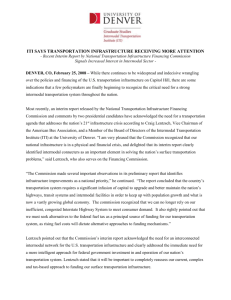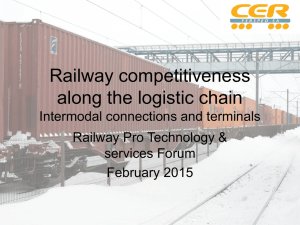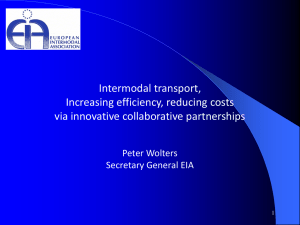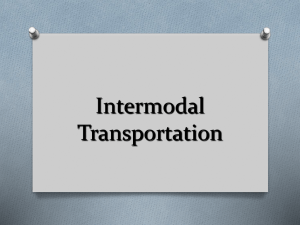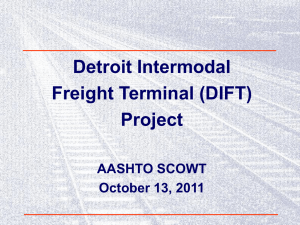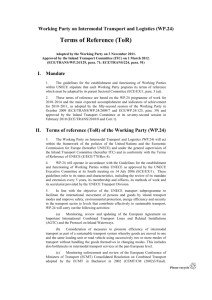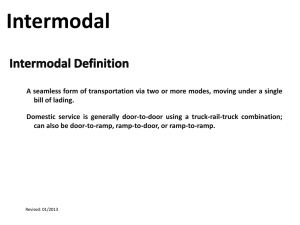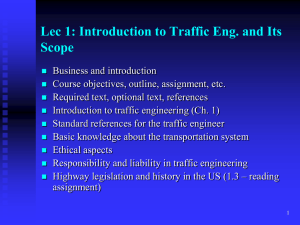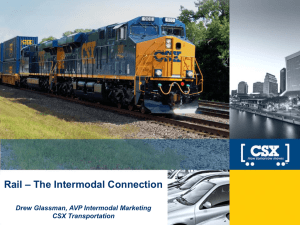interim
advertisement
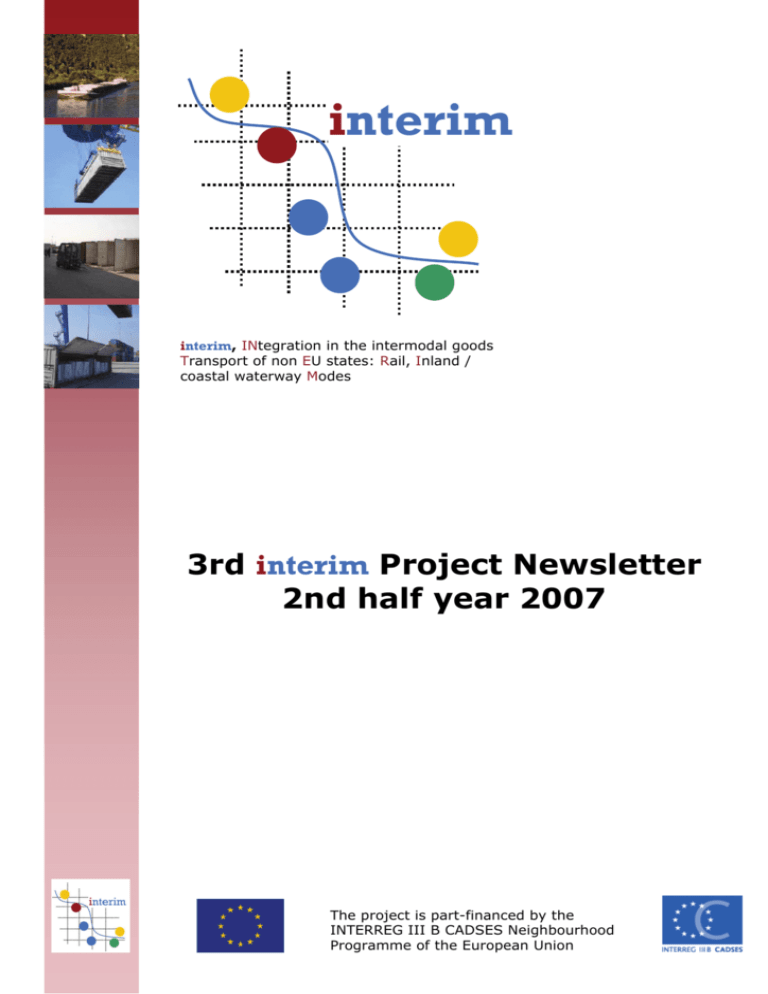
interim interim, INtegration in the intermodal goods Transport of non EU states: Rail, Inland / coastal waterway Modes 3rd interim Project Newsletter 2nd half year 2007 The project is part-financed by the INTERREG III B CADSES Neighbourhood Programme of the European Union interim newsletter LEAD PARTNER Content Æ Preface Æ Project News Æ Mr. Ralf Lipinski, VIOM GmbH: Approach for an Internet Based Intermodal Planning Tool Æ Mr. Stefan Herold: Comparison of different intermodal IT-Tools Æ Improvement of Intermodal Market Æ Contact Data / Facts Prof. Milos, Prof. Dujmovic and Prof. Sonntag presenting results of interim project at the LINDI conference, Wildau, DE Prefata Preface The increasing European goods transport requires new innovative transport concepts. The integration of neighbourhood countries in Europe, compensations of existing hinterland and border crossing bottlenecks and the future role of different transport modes are integrated elements in forward looking transport plans. Especially, the intermodal transport shall provide solutions to shape the tomorrow goods transport. Market barriers which prevent intermodal transport from a higher market share have to be analysed and removed. One decisive barrier is the underdeveloped IT and communication infrastructure between the various market actors in the intermodal market. That’s the point where the interim project starts off. A decisive project element is the development of IT-Tools as an approach for an internet based intermodal planning tool. Identifying user groups, analysing their needs and requirements, but also the technical realisation, set up and testing phase are central elements of interim. The content specification has been fulfilled and will be shortly presented in following. Also the programming has been started by the VIOM GmbH. Mr. Ralf Lipinski, head of programming process gives a brief overview about their working steps. Mr. Stefan Herold (University of Applied Sciences bfi Vienna) worked out his master thesis about intermodal planning tools. He presents his main results and states the positioning of interim IT-Tools in these specific scientific landscape. Cresterea volumlui de marfuri transportate in Europa implica concepte de transport inovative. Integrarea europeana a tarilor vecine, compensarea locurilor strimte existente in prezent in conexiunea porturilor cu teritoriul adiacent si la trecerile frontierelor, precum si viitorul rol al diferitelor moduri de transport sunt elemente integrate in planurile viitoare de transport. Transportul intermodal in special, va furniza solutii care vor modela transportul de marfuri in viitorul apropiat. Barierele comerciale care impiedica extinderea segmentului de piata de transport intermodal trebuie analizate si inlaturate. O bariera decisiva consta in slaba dezvoltare a infrastructurii TI si de comunicare intre principalii factori de pe piata din sectorul de transport intermodal. Acesta este punctul de plecare al proiectului interim. Un element decisiv al proiectului consta in dezvoltarea de solutii TI concretizate in realizarea unui instrument bazat pe internet de planificare in transportul intermodal. Identificarea grupurilor de utilizatori, analiza cerintelor, precum si realizarea tehnica, instalarea si faza de testare reprezinta elementele de baza ale proiectului interim. Continutul va fi prezentat pe scurt in continuare. De asemenea, programarea a fost inceputa de catre VIOM GmbH. Dl. Ralf Lipinski, conducatorul echipei de programare va descrie pe scurt pasii facuti pana acum. Dl. Stefan Herold (University of Applied Sciences bfi Viena) a dezvoltat teza sa de masterat pe domeniul instrumentelor de planificare intermodala. El prezinta principalele rezultate obtinute si expune rolul instrumentelor TI interim in contextul stiintific al problemelor sus mentionate. 2 interim Project News Public Workshop Wildau, 13th September 2007 On September 13th an additional workshop was held in Wildau, DE, in cooperation with the Interreg A-B Landbridge project (www.ablandbridge.eu). Content of the joint workshop was “Needs and instruments for spatial planning / regional development in the field of intermodal goods transport”. Mr. Dr. Walter Vassallo presented the A-B Landbridge project. Mr. Dr. Markus Hesse, as guest from the FU Berlin, gave an overview of “Logistics and Spatial Development: Regional Development Outcomes, Spatial Plannings Needs“. Participants at the workshop in Wildau, DE Central questions which have been discussed among participants: • In which fields and how is the intermodal goods transport integrated in the spatial planning? • Where do deficits occur regarding the consideration of intermodal goods transport in spatial planning? • Which indicators can be used to reflect the specific role of intermodal goods transport in the regional / cross border development? • Regarding future goods transport scenarios what kind of instruments are needed to integrate intermodal goods transport in the frame of spatial planning in a better way? Presentations On September 13th-15th the LINDI conference “International Symposium on Logistics and Industrial Informatics” took place in Wildau. Mr. Meimbresse, TFH Wildau, and Mr. Lipinski, VIOM GmbH, presented the interim project in context of “Tools for Route Planning of Intermodal Logistic Chains and Improvement Potential as well as Adaptation for Spatial Planning Purposes”. Furthermore our partners from Croatia, our partner viadonau from Austria and GVZ Glauchau, Germany, joined the conference and disseminated the interim project. Project Workshop Our last interim project workshop “New liner concepts and new concepts for value added services in the intermodal market” was held on 7th November in Novi Sad, Serbia, with more than 60 participants. Connected to the workshop in Serbia the 5th international logistic fair in Novi Sad took place. Mr. Meimbresse, TFH Wildau, presented the interim project at the fair conference to logistic experts. Next Step The next interim partner meeting for evaluating new project outcomes and working on further actions is scheduled on February 8th 2008 in Vienna, Austria. www.interim-online.eu Mr. Meimbresse and Mr. Lipinski at the LINDI conference Our homepage is constantly updated. Workshop presentations, workpackage documents, newsletters, further publications and news about the project are available! 3 interim interim IT-Tool – Approach for an Internet Based Intermodal Planning Tool, Mr. Ralf Lipinski Like business actors in other markets, transport and logistics service companies in the intermodal transport market need applications for planning, management and monitoring. Because in the intermodal transport business different actors are involved in the generation of a service, the requirements regarding complexity, interconnectivity and flexibility of such applications are higher. Especially IT-based instruments are needed to cover the problems along the supply chain. Despite the fact that progress has made in establishing ICTs, the existing solutions are not in line with the market needs. The interim IT-Tool as a further development of the Route Planning and Infrastructure Information Tool ECO4LOG meets this complexity by connecting required information for logistic service providers and operators (B2B) as well as spatial planners and administrations (A2A). Aim is that users of intermodal transportation services shall be supported in their strategic transportation planning process by reliable information about intermodal transport facilities in the defined clusters. A decision support system shall enable them to choose between a number of alternative transport routes and modes based on decision criteria such as availability of transport possibilities, needed services and transport time and costs. Routing without consideration of existing market offers Blue: Inland waterway Green: Rail Routing with consideration of existing market offers Red dotted: BOHEMIA Combi offer. This offer can be selected and will serve as a defined “backbone” for the complete routing process. Figure: Example B2B - Integration of market offers Calculation / presentation of feasible distances in given time steps for all directions from a starting point under consideration of the network‘s parameters – Isochrones Time view Scenario features: Modification of travel times, velocity Addition/change of network elements → Changes in accessibility visible Route planning and infrastructure information tools consist in general of an infrastructure network database and a routing algorithm. For intermodal planning purposes the network database contains road, rail, and inland navigation information regarding all included network segments. Moreover, intermodal terminals serve as nodes connecting the different networks (modes of transport). Various routing algorithms to calculate the shortest path in networks exist. The Dijkstra-algorithm describes a solution for a directed, weighted graph. For representing the intermodal terminals as interfaces between different transport networks the consideration of information are needed e.g. for distances to cover, transhipment times, costs and energy consumption inside the terminal. This kind of information is essential for the calculation and comparison of different transport alternatives or paths in the network. Therefore, a work-around is needed to consider needed information properly. The basic idea is to integrate a microscopic view showing that a node concerning transport and transhipment processes also consists of (virtual) segments representing the connections to the transport modes and can be weighted with values (time, distance, costs, energy consumption). Adding to the nodes n additional segments s, a geometrical representation of processes/values inside the terminals is possible. ni,k si,k Also for energy consumption Ecological View ni Also for cost calculations Cost View simple connectivity between network segments ni,k-1 consideration of intermodal terminals with weighted segments Figure: Logical representation of intermodal terminals in a Dijkstra graph Figure: Example A2A - Accessibility Analyses 4 interim Overview Comparison of different intermodal IT-Tools, Mr. Stefan Herold A focal aim of the EU is the strengthening of intermodal transport as a central element of sustainable future transport solutions regarding the steady growth of European freight transport. To turn out the advantages of the different transport modes like capacity, energy consumption, flexibility, environmental effects and safety intermodal transport chains have to be realized to attract the intermodal transport to the market users. The high complexity of intermodal transport solutions regarding planning processes, organization and realizations asks for software orientated solutions to support the intermodal transport market. As next step the criteria results were added and summarized in the three criteria groups as shown in the given overview table below. The analysed tools showed different advantages in the different analysed criteria. As illustrated the ECO4LOG-ITTool (the forerunner of the interim IT-tool) attains the highest score regarding ‘Usability and Users’, ‘System and Applications’ and ‘Results and Practicability’. The ECO4LOG-Tools showed significant advantages for generating intermodal transport chains at this time. The tool is useable by different users as logistic chain organisers (LCO), logistic chain providers (LCP) and information users. It further provides each user essential information for transport chain planning as well as other important information like opening times or contact information of terminals and handling operators. Depending on particular targets of each user the tools proposes the fastest (time), shortest (distance), cheapest (costs) as well as the ecological friendliest transport route by combining the different modes of transport. Regarding geographical constraints the tool includes maps and information for Austria, Germany, Poland, Slovakia and Slovenia as well as connections to the North Sea and the Adriatic Sea. During the last years several intermodal tools have been developed in that context. The tools show different focal points and are differently characterised through defined user groups, techniques, geographical constraints and operability. Mr. Herold from the University of Applied Sciences bfi Vienna worked out his master thesis about intermodal planning tools and analysed differences. In this process, different criteria groups were defined as ‘Usability and Users’, ‘System and Applications’ as well as ‘Results and Practicability’ for the comparison of the tools. The first criteria group discusses aims, main functions, users and essential input parameters. ‘System and Applications’ refers to users, databases and geographical constraints of the tools. In the last criteria group the quality and quantity of the outputs as well as the benefit for the different user groups are discussed. After specifying the criteria groups, each criteria was quantified. A quality ranking (1 = low evaluation, 5 = high evaluation) was elaborated and each criteria has been weighted and related to different valences. The operations of the tools have been evaluated with the predefined criteria depending on the performance degree of each single criterion. ECO4LOG www.eco4log.de The full version of master thesis available at www.interim-online.eu. ptv intermodal guide www.ptv.de ETNA is DISMOD www.alsodanube.at www.imlfaunhofe r.de/302.html Usability and Users 14 14 6 5 System and Applications 18 16 14 19 Results and Practicability 15 15 12 14 Final score 47 45 32 38 Table: Evaluation of selected tools 5 interim Improvement of intermodal market Table: Concept of liner routes towards the Black Sea region Workpackage 4.1: “Development of new intermodal service concepts liner services” Mrs. Jolanta Skalska Among the countries and regions involved in the interim project a concept for new intermodal liner railway and inland waterways services has been developed. Maritime connections between ports and hinterland as well as inland connections between inland terminals have been regarded. Liner services shall operate on a fixed route, with fixed timetable, stop shortly in nodes/terminals for rapid loading/unloading or change of wagons/wagon groups, operate all–year– round and have broad access for interested companies. The need for such services has been identified on the basis of supply and demand side evaluation in each country. Within the supply side the existing transport services have been investigated: existing intermodal trains with containers, swap bodies and trailers, conventional trains containing significant intermodal potential and inland waterway services. Also a part of road transport has been identified for possible shifting to railways and inland waterways. On the demand side the economical situation and potentials of regions have been analysed and industrial clusters important for intermodal transport have been elaborated. Based on national proposals liner services in the CADSES area have been carried out. Based on national proposals liner services in the CADSES area have been suggested and consulted with interested intermodal stakeholders (transportation and logistics companies, consignors, regional administrations). Possible liner services on the following connections have been highlighted: North Sea/Baltic ports – Central Europe, ARA ports (Amsterdam, Rotterdam, Antwerp)/Duisburg – South East Europe, South German Industrial Clusters – South–East Europe. Workpackage 4.2: “Development of new intermodal service concepts value added services” Mr. Gerhard Schilk Intermodal terminals hold an important role in our today’s economy, as they provide transhipment facilities and operations for traffic and transport enterprises. Efficient interfaces are a crucial element enabling interrelations between all means of transport in order to offer multimodal / intermodal transport chains. Intermodal terminals (e.g. logistics terminals, freight villages, rail terminals, inland ports, sea ports) influence and stimulate also their regional and economic regions in which they are located. Action 4.2 did focus on the development of new intermodal service concepts, so called Value Added Services (VAS), for intermodal terminals located in the interim geographical region. First, the 6 interim Improvement of intermodal market relevant terminals have been identified based on their regional and local importance (max. 6 terminals per country have been considered). Next, they have been grouped into three pre-defined types of terminals (railway/logistics, inland port and sea port). Afterwards, the terminals were described in terms of current offered and future planned services. Hereby also future trends have been taken into account (e.g. industrial developments, cargo flows). Following, the suggested VAS have been discussed with external actors from the transportlogistics industry and public sector. Finally, current prevailing intermodal terminal problems have been identified, based on which recommendations have been formulated for being presented to both transport-logistics industry actors and public decision makers. Basically there is a big difference between core services (e.g. transhipment, storage) and VAS. The findings of the Action 4.2 were that intermodal terminals offer various VAS to their customers. This, however, depends very strongly on their core competencies and main business areas. Railway/logistics terminals offer different services than inland ports and freight villages offer significantly more services than all other types of terminals. Today, most intermodal terminals offer VAS for container and automotive, while only few offer a full-range of services (= one-stop-shop). This especially becomes true for freight villages and sea ports, while pure railway and logistics terminals aim at optimising their internal transhipment processes. What about future VAS? In the future biofuels (bio-diesel, bio-ethanol) shall be become an important VAS, however, this not only in EU-Member States, but also in the Western Balkan region. As most railway/logistics terminals (esp. in Germany and Austria) work close to their capacities strategic co-operations among them become also an important aspect for improving available services in the intermodal terminals. Moreover, terminals intend to become trimodal terminals, wherever possible, as this circumstance will attract additional enterprises settling in or around these logistics nodes. The activities will include a detailed analysis of supply and demand of intermodal transport services and integration of IT&C tools. Particular emphasis shall be put on the major threats and bottlenecks that have been identified, and specific examples from Austria will be described. A detailed analysis on the connectivity of selected harbours from Austria, Croatia, Romania, and Serbia to different modes of transportation, data on infrastructure, capacities, and traffic through each connection of the port, and a summary of the improvement plans for the hinterland connectivity of these harbours shall be provided. Based on the above mentioned data, a critical analysis of the deficit between capacity and demand for each connection of the selected harbours shall be performed. The objective of the action consists on the development of strategic concepts to improve the connectivity of selected harbours, the threats for the liner services, concepts to improve the speed, the deficit of capacities, and the major factors that might contribute to the improvement of the transport quality by the integration of the new EU member states in the CADSES area. Workpackage 4.4: “Intermodal action plan and integration in regional development plans” Mr. Thomas Jerger At present an intermodal action plan which bases on a SWOT analyses will be elaborated. The partners identify and describe their country-specific strengths, weaknesses, opportunities as well as threats in the intermodal transport business, categorize them according to policy fields and give recommendations for measures to improve the situation. Finally the development of an intermodal goods transport action plan for regions involved taking into account the requirements of regional development plans and suggestions for integration of intermodal issues in the regional development plans will be made. Workpackage 4.3: “Improvement of hinterland connectivity of harbours” Ms. Rita Avram The tasks of WP 4.3 action consist on the review of the achievements and future actions within EU member states regarding the improvement of the hinterland connectivity of harbours. 7 interim Contact Data, Facts CONTACT GERMANY Representative of the Lead Partner Mr. Prof. Sonntag University of Applied Sciences Wildau hsonntag@igw.tfh-wildau.de Project Manager Mr. Meimbresse University of Applied Sciences Wildau bmeimbre@igw.tfh-wildau.de Tel: +49 3375 508-355 Fax: +49 3375 508-983 Scientific Assistant Mr. Jerger University of Applied Sciences Wildau thomas.jerger@tfh-wildau.de GVZ Development Corporation Southwest Saxony Ltd. Mr. Wagener wagener@gvz-suedwestsachsen.de EHG Ennshafen Ltd. Mr. Mag. Steindl c.steindl@ennshafen.at Wiener Lokalbahnen Mr. Retscher gerald.retscher@wlb.at CONTACT BULGARIA Technical University Varna Ms. Natalia Nikolova natalia@dilogos.com CONTACT CROATIA Collegium Flumensis Polytechnic of Rijeka Mr. Prof. Milos ivan.milos@veleri.hr CONTACT ROMANIA GSG Knape Gleissanierung GmbH Ms. Skalska skalska@gsg-knape.de Ovidius University of Constanta Mr. Prof. Mamut emamut@univ.ovidius.ro CONTACT AUSTRIA CONTACT SERBIA via donau – Österreichische Wasserstraßengesellschaft mbH Mr. Schilk schilk@via-donau.org University of Novi Sad, Faculty of Technical Sciences Mr. Prof. Georgijevic georgije@uns.ns.ac.yu Facts The project is part-financed by the INTERREG III B CADSES Neighbourhood Programme of the European Union. Budget: 1.2 Mio. € (including all European co-funding) Duration of the project: 01 May 2006 to 30 April 2008 Homepage: www.interim-online.eu
